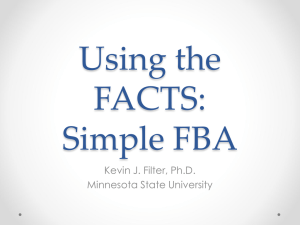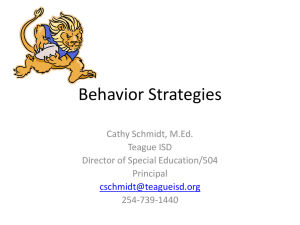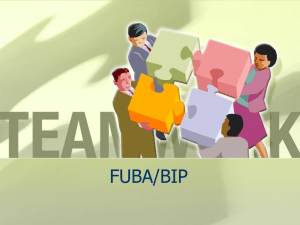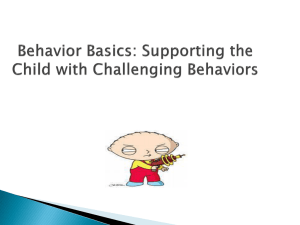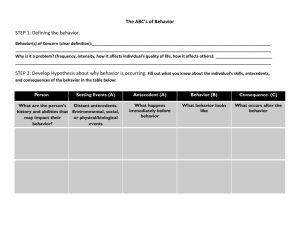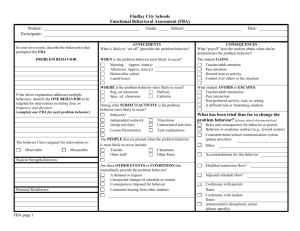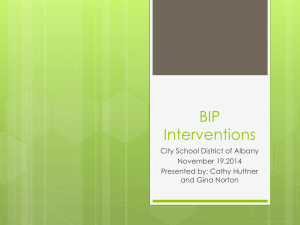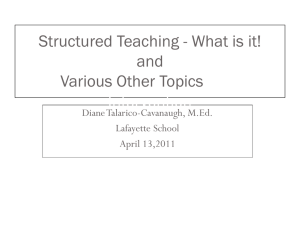Functional Behavior Assessment Template Lancaster County
advertisement
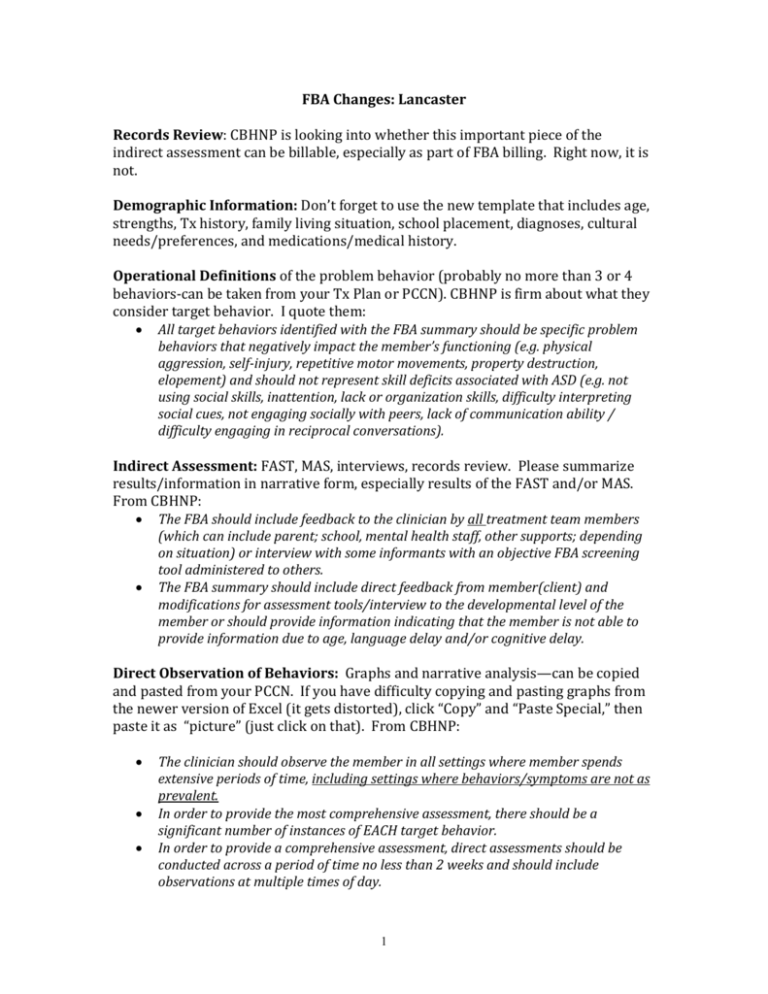
FBA Changes: Lancaster Records Review: CBHNP is looking into whether this important piece of the indirect assessment can be billable, especially as part of FBA billing. Right now, it is not. Demographic Information: Don’t forget to use the new template that includes age, strengths, Tx history, family living situation, school placement, diagnoses, cultural needs/preferences, and medications/medical history. Operational Definitions of the problem behavior (probably no more than 3 or 4 behaviors-can be taken from your Tx Plan or PCCN). CBHNP is firm about what they consider target behavior. I quote them: All target behaviors identified with the FBA summary should be specific problem behaviors that negatively impact the member’s functioning (e.g. physical aggression, self-injury, repetitive motor movements, property destruction, elopement) and should not represent skill deficits associated with ASD (e.g. not using social skills, inattention, lack or organization skills, difficulty interpreting social cues, not engaging socially with peers, lack of communication ability / difficulty engaging in reciprocal conversations). Indirect Assessment: FAST, MAS, interviews, records review. Please summarize results/information in narrative form, especially results of the FAST and/or MAS. From CBHNP: The FBA should include feedback to the clinician by all treatment team members (which can include parent; school, mental health staff, other supports; depending on situation) or interview with some informants with an objective FBA screening tool administered to others. The FBA summary should include direct feedback from member(client) and modifications for assessment tools/interview to the developmental level of the member or should provide information indicating that the member is not able to provide information due to age, language delay and/or cognitive delay. Direct Observation of Behaviors: Graphs and narrative analysis—can be copied and pasted from your PCCN. If you have difficulty copying and pasting graphs from the newer version of Excel (it gets distorted), click “Copy” and “Paste Special,” then paste it as “picture” (just click on that). From CBHNP: The clinician should observe the member in all settings where member spends extensive periods of time, including settings where behaviors/symptoms are not as prevalent. In order to provide the most comprehensive assessment, there should be a significant number of instances of EACH target behavior. In order to provide a comprehensive assessment, direct assessments should be conducted across a period of time no less than 2 weeks and should include observations at multiple times of day. 1 Skill Deficits: On this page, please write a brief statement explaining why that particular skill deficit seems to be impacting target behavior. You can put this in right after the description of the skill (page 7) in the template. Example: Communication Skills: The client has difficulties with requesting what they need, including items, activities, attention, information, changes in the environment, or help. He/she has difficulties in conversational skills and answering questions, understanding non-verbal or verbal language, or following directions. John is primarily non-vocal and relies on inconsistent and/or ineffective use of PECS to make his needs known. Preference Inventory: It would be better in this section if you keep the main categories, and then just list and/or describe (candy is not enough—gummy bears is better) in order of preference within each category. Just delete the inapplicable items—it’s hard to read with just numbering them and most don’t apply to a lot of our clients. Describe Antecedent Setting/Contextual events and Consequent events with Conditional Probabilities From CBHNP: The FBA summary should include a description of both “fast” and “slow” triggers for the target behaviors and identify what that suggests about the function of the behavior. The FBA summary should describe BOTH the most frequent caregiver reactions/responses to the target behavior and identify what this suggests about the function of the behavior (Page 3 of our FBA Template). Setting or Contextual Events—“slow triggers”: A setting event can be anything that increases the likelihood of the problem behavior occurring. A setting event can be something that occurred in the near distant past (a fight last night, sitting on the bus too close to someone that was screaming, not getting enough sleep). A setting or contextual event can also include changes in the current environment (the lights are too bright, there are a lot of people in the room, it is noisy). Another setting event can be the person you are working with. What might have occurred prior to the behavior, even within a week or so, that may have contributed to the behavior. Antecedent Events: This is the immediate “fast” trigger—ex: the demand, but can be anything that happens that directly triggers the behavior. Consequence: This is what happens directly after the behavior, and may be maintaining the behavior. For example, task is presented, child cries, task is 2 removed. The removal of the task is making the child's escape-motivated behavior very successful. Conditional Probability: The likelihood that a target behavior will occur in a given circumstance; computed by calculating (a) the proportion of occurrences of behavior that were preceded by a specific antecedent variable and (b) the proportion of occurrences of problem behavior that were followed by a specific consequence. Basically…it’s ____out of ____ observed opportunities, put into percentage. NEW: We must include graphs for Antecedent and Consequent Behaviors in addition to our regular graphs. One for antecedent and one for consequent conditions. Please use column (bar) graphs for this since it summarizes separate elements. Provide these graphs with narrative descriptions, describing and comparing the conditional probabilities of a behavior occurring given the specific antecedent or consequent event. Ex: See Graphs Below: I have included just a brief narrative to provide an example. These graphs were taken from a CBHNP training and it’s difficult to interpret another person’s data (they didn’t provide analysis), but this is the general idea: 3 Bobby - Antecedent Conditions 16 t a 14 r 12 g e 10 t 8 F r e q u e b n e c h y a v o i f o r 6 SIB 4 Physical Aggression Tantrum 2 0 Antecedent Conditions Antecedent Conditions: Data indicate that SIB is highest in the alone and task demand conditions, with slightly lower frequency in the rule enforcement, redirection and low attention conditions. Physical aggression occurs primarily in response to a task demand, with considerably lower frequency for denial of request, rule reinforcement and low attention. Tantrums escalate in the denial of request condition, with low frequency in the rule reinforcement and re-direction conditions. Behavior SIB Antecedent Event and/or Setting Event if known Task Demand Rule Enforcement Re-direction Alone Low attention Denial of Request 4 % occurrence of behavior given this antecedent 24 % 17 % 21 % 24 % 14 % 0% Physical Aggression Tantrum Task Demand Rule Enforcement Re-direction Alone Low attention Denial of Request 67 % 13% 0% 0% 7% 13 % Task Demand Rule Enforcement Re-direction Alone Low attention Denial of Request 0% 11% 6% 0% 0% 83% 5 Bobby - Consequent Conditions 16 T 14 a r 12 g 10 e t 8 F r e q u e B n e c h y a v o i f o r 6 SIB 4 Physical Aggression 2 Tantrum 0 Consequent Conditions Consequent Conditions: Data indicate that Tantrums are maintained when given access to what was demanded indicating that the perceived function is to obtain access. Physical aggression is maintained when given a time-out, and is also maintained when the demand is repeated or enforcement is removed, but attention appears to be the hypothesized function. SIB appears to be maintained across conditions with the exception of when the demand is removed or the client is put into time-out, indicating that attention is not the perceived function of SIB. See Conditional Probability Chart on next page 6 Behavior SIB Physical Aggression Tantrum Removal of Demand Repeated Demand Removal of Enforcement Repeated Enforcement Lecturing Given Access Time-Out % occurrence of behavior given this consequence 21 % 14 % 24 % 14 % 27 % 0% 0% Removal of Demand Repeated Demand Removal of Enforcement Repeated Enforcement Lecturing Given Access Time-Out Removal of Demand Repeated Demand Removal of Enforcement Repeated Enforcement Lecturing Given Access Time-Out 0% 20 % 13 % 0% 0% 0% 67 % 0% 0% 5.5 % 11 % 5.5% 78 % 0% Consequence Graphs: Line Graph for Data Analysis across time/sessions: Label your x and y axes, give the graph a title, include trend lines and a narrative describing trend analysis. Put in dates. Put in the legend to describe target and replacement behaviors. If there are gaps in your data entries, try to leave those data points unconnected. Hypothesis Statement: You must have at least one hypothesis statement for each target behavior. Different topographies (hitting, kicking) can be combined in one statement if the antecedent (ex: demand placed) and the function (ex: escape/avoid task) are the same. From CBHNP: The hypothesis statement(s) should be supported by the data presented. The FBA summary should includes a hypothesis statement for EACH target behavior that includes all necessary components; including antecedents, details involving the antecedents, consequences / function of behavior. 7 Recommendations: Copy and paste your Methods for each problem behavior that you are covering in the FBA. Be sure to separate the specified behavior, and have your interventions correspond with the strengths/preferences of the client for more effective potential implementation. Separate who does what: Parent will…TSS will…BSC will…MT will…John will….Psychologist will….. 8 Chester County Intermediate Unit Home and Community Services Functional Behavior Assessment Functional Behavior Assessment (Delete all instructions in italics/parentheses/red type prior to submitting this document, including this statement!). Client's Name: Date of Birth: Age: Current BHR Services: BSC___hrs/wk. or mo. TSS____hrs/wk. Submitted by: MT___hrs/wk Date Submitted: Clinician Contact Information: Client Strengths (include family and school information): Treatment History: Diagnosis: Axis I: Axis II: Axis III: Axis IV; Axis V: GAF current GAF past 1 Medications and Pertinent Medical Conditions: Dates of FBA: Settings for FBA: Types/Sources of Information: (List: TSS data sheets, FAST, MAS, observations, and/or Interviews, evaluation reports) Description of Behaviors of Concern: (these must be specific descriptions of problem behaviors that negatively impact daily functioning, but are not related to skill deficits. Skill deficits include social skills, inattention, disorganization and lack of reciprocity during interactions.) 1. 2. 3. 4. Indirect Observations of Behaviors (FAST, MAS, interviews, behavior rating scale with parents, caregivers, teacher and client. Please indicate each method used when summarizing. For example: Results of the FAST completed with _____'s mother indicate that ..................... If client is unable to provide feedback, please indicate that this is due to age, or to developmental, behavioral and/or cognitive delays) 2 (Provide narrative summaries of indirect observations and feedback here.) Based on Indirect and Direct Observation: Behavior Typical Frequency 1-5x/day week 6-10x day/week >10x/day/ week 1-5x/day week 6-10x day/week >10x/day/ week Typical Duration Typical Severity 1-5x/day week 6-10x day/week >10x/day/ week 1-5x/day week 6-10x day/week >10x/day/ week 1-5x/day week 6-10x day/week >10x/day/ week Direct Observations of Behaviors: (Provide graphs and narrative analyses for each target behavior. Multiple target behaviors can be included in a single graph when appropriate. Graphs must include a title, Y-axis with the dimensions of the behavior, X-axis with dates of observations, and a legend (key) designating each behavior). 3 Summary of Behavioral History Behavior How long has this been a problem? Intervention and/or Pro-Active (Antecedent) Efforts 4 Impact (decreases, maintains, exacerbates behavior of concern) Analysis of Data Collection: Instructions: When the answer is YES, add details on the lines provided, indicating which behaviors are relevant. If the answer is no, delete the “Yes” and lines Physiological and Medical Factors: 1. Could the behavior be the result of a medical or psychiatric condition or any form of physical discomfort? NO YES _______________________________________________________ __________________________________________________________ 2. Could the behavior be related to a side effect of medication? NO YES _______________________________________________________ __________________________________________________________ 3. Could the behavior be the result of some physical deprivation condition (thirst, hunger, lack of rest, etc.)? NO YES _______________________________________________________ 5 Antecedent Events: 1. Are there circumstances in which the behavior ALWAYS occurs? NO YES _______________________________________________________ __________________________________________________________ 2. Are there circumstances in which the behavior NEVER occurs? NO YES _______________________________________________________ _____________________________________________________________ 3. Does the behavior occur only (or more often) during particular activities? NO YES _______________________________________________________ _____________________________________________________________ 4. Does the behavior occur only with (or more likely with) certain people? NO YES _______________________________________________________ _____________________________________________________________ 5. Does the behavior occur in response to certain stimuli? (demands, termination of preferred activities, tone of voice, noise level, ignoring, change in routine, transitions, number of people in the room, etc.) NO YES _______________________________________________________ _____________________________________________________________ 6. Does the behavior occur only (or more likely) during a certain time of day? (morning, afternoon, end of school day, evening) NO YES _______________________________________________________ 6 ________________________________________________________ A Conditional Probability is the likelihood that a target behavior will occur in a given circumstance. Behavior Behavior Antecedent Event and/or Setting Event if known-specify Consequence 7 % occurrence of behavior given this antecedent % occurrence of behavior given this consequence Skill Deficits Related to Behaviors of Concern: (Could the behavior be related to any skill deficits? check all that apply: include a brief statement describing how it impacts specific problem behavior) Academic Skills: Task requirements present as being too challenging for the client’s current skill level. ___ Participation Skills: The client has difficulty with participating in nondirected, semi directed, teacher-directed, or peer-directed activities. The student has difficulty in small or large group instruction. ___Social Skills: The client has difficulty acquiring and/or maintaining peer friendships. The client often withdraws from social interaction. The client is often verbally and/or physically aggressive in social interactions. ___Communication Skills: The client has difficulties with requesting what they need, including items, activities, attention, information, changes in the environment, or help. He/she has difficulties in conversational skills and answering questions, understanding non-verbal or verbal language, or following directions. ___Organizational Skills: The client has difficulty with organizing school supplies, study area, time, or projects, organizing class notes, or dividing assignments into task. ___Self-Regulation Skills: The client has difficulties with staying on-task, completing work assignments, handling stressful situations, calming self when agitated, following rules, or difficulty transitioning between activities/places or people. Difficulty with problem solving. ___ Study Skills: The client has difficulty with studying for tests, taking tests, taking notes from lectures, or using studying techniques. ___Motor Skills: The client has difficulty with gross motor skills (e.g. running, raising arms, putting feet together, squatting, bending at waist, etc.) or fine motor skills (e.g. pointing, counting with fingers, holding a pencil/pen, holding a fork/spoon, pressing a computer key, using a mouse, etc.). S/he has difficulty with imitating others’ actions. ___ Functional Skills: The client has difficulty with performing activities of daily living (e.g. eating, dressing, toileting, grooming). 8 ___Play Skills: The client has difficulty with actively exploring activities/toys in their environment (inside or outside) to play with during leisure time, playing with the items as designated, or engaging in interactive play with peers during activities. Consequence Factors: 1. Does the behavior allow the student to gain something? A. Preferred activities or items? Indicators: The behavior often occurs when the student sometimes or always regains an item or activity that has been taken away or terminated. The behavior often occurs when the student sometimes or always gains access to an activity or item that he was told he couldn’t have. The behavior rarely occurs when the student is given free access to his or her favorite items or activities. NO YES _______________________________________________________ _____________________________________________________________ B. Peer or adult attention? Indicators: The student frequently approaches others. The student frequently initiates social interaction. When the behavior occurs, someone usually responds by interacting with the student in some way (i.e. verbal reprimand, redirection, comforting statements). The behavior rarely occurs when the student is receiving attention. NO YES _______________________________________________________ _____________________________________________________________ 2. Does the behavior allow the student to postpone, avoid, or escape something such as task demands, social interaction, etc.? Indicators: The behavior often occurs when the student sometimes or always postpones or escapes the task demands placed upon him. The behavior rarely occurs when few demands are placed on the student or when the student is left alone. The student is often noncompliant when asked to complete tasks and the student sometimes or always postpones or escapes the tasks. The behavior often occurs prior to predictable demands and the student sometimes or always avoids or postpones the tasks. NO YES _______________________________________________________ _____________________________________________________________ 3. Does the behavior provide stimulation as an alternative to the student's lack of active engagement in activities? 9 Indicators: The behavior occurs frequently when the student is alone or unoccupied. The student seems to have few known reinforcers or rarely engages in social interaction activities. When the student engages in the behavior, others usually respond by not attending to the behavior. NO YES _______________________________________________________ Preferences/Reinforcer Inventory use a scale of 1 to 5 (1 being the most enjoyable) These are suggestions below. You can retain the categories and list the preferences of your client in order of preference—please be specific.) Activities and sports Puzzles ___ Games ___ Books ___ Sensory toys ___ Musical instruments ___ Computer games ___ Action figures ___ Painting ___ Bowling ___ Play dough ___ Other: ___ Trampoline ___ Biking ___ Swing set ___ Slide ___ Amusement parks ___ Swimming ___ Other _________ ___ Roller-skating ___ Skateboarding ___ Other _________ ___ Television and video Disney movies ___ Animated movies ___ Other _________ ___ Animal videos ___ Cartoons ___ Other _________ ___ Treats Candy ___ Fruit ___ Pretzels ___ Crackers ___ Chips ___ Other _________ ___ Ice cream ___ Cookies ___ Other _________ ___ Beverages Soda ___ Juice ___ Other _________ ___ Milk ___ Water ___ Other _________ ___ Reading items Pop-up books ___ Picture books ___ Books with sound ___ Sensory books ___ Puzzle books ___ Coloring books ___ Sticker books ___ Magazines ___ Other _________ ___ Animals Cat ___ Dog ___ Rodent ___ Fish ___ Bird ___ Other _________ ___ Computer CD-Rom games ___ Internet surfing ___ Other _________ ___ Music 10 Country ___ Rock ___ Oldies ___ Classical ___ Rap/Hip-hop ___ Other _________ ___ Hypothesis Regarding Function(s) of Behaviors Obtain: Activity, Item, Attention, Sensory Stimulation Escape: Activity, Item, Attention, Sensory Stimulation Antecedent Behavior What does s/he get? What does s/he avoid/escape/delay? HYPOTHESES When ____________________(antecedent to behavior of concern),______ (student) _______________________________ (behavior of concern) in order to ____________________________________ (perceived function of the behavior). When ____________________(antecedent to behavior of concern),______ (student) _______________________________ (behavior of concern) in order to ____________________________________(perceived function of the behavior). 11 When ____________________(antecedent to behavior of concern),______ (student) _______________________________ (behavior of concern) in order to ____________________________________(perceived function of the behavior). When ____________________(antecedent to behavior of concern),______ (student) _______________________________ (behavior of concern) in order to ____________________________________(perceived function of the behavior). Recommendations: CBHNP: Copy and Paste your Methods sections from Treatment Plan for each problem (target) behavior included in this FBA. 12
